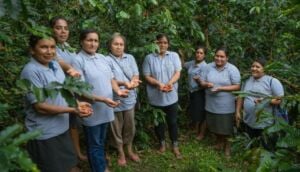Until now little was known about fertilizer use for cocoa. For instance, to what extent does fertilizer affect cocoa farms? How much does it cost, and which returns on investment can be expected?
A pilot study on the impact of fertilizer by Francois Ruf from CIRAD, funded by IDH, Mars and Yara, gives an interesting insight into the added value of fertilizer. It shows that fertilizer use on degraded farms with mature trees has a clear positive impact on the productivity of cocoa.
The study was carried out in Ghana and Cote d’Ivoire. In these countries, entire regions, such as the famous cocoa belt of Soubre, are known to suffer from tree mortality and declining yields. Fertilizer can be one of the solutions for the problems cocoa farmers and companies face. This study showed that after just one year of application the foliage on degraded farms is widely rebuilt. Farmers are talking about the impact on their farms – cocoa trees are doing so much better that in some instances they can no longer see the sky. Fertilizer use has also slowed the rate of tree mortality and resulted in higher yields and better, higher-quality pods. There was a clear impact on production, despite significant variability in productivity explained by rainfall and the degree of maintenance. A rough calculation shows that the estimated potential market for fertilizer is over 1 million tons. This represents an annual revenue of at least US$500 million to the fertilizer industry and credit institutions.
What the study shows us is that there is a clear business opportunity for the cocoa industry to further explore fertilizer use in order to improve production and quality of cocoa. We as IDH support this by linking fertilizer organizations with farmer cooperatives, in an aim to build an effective and sustainable cocoa input supply industry. A group of industry frontrunners are already setting targets for distribution of fertilizers to their suppliers, thereby generating an aggregate demand that is attractive for fertilizer companies to develop the market.
Find the complete study on http://www.idhsustainabletrade.com/cacao-fertilizer-use











2 Responses
But why should we double cocoa production?
Farmers and indeed countries like Ghana have few alternative domestic uses for cocoa, as such they have no significant control over the international price of cocoa because it is essentially a buyer’s market.
The cocoa plant has a long gestation period – 5 years – during which nothing else can be planted in that space, taking up land that could have been used for domestic food production, or alternative high-value crops that can also be used domestically.
Increasing cocoa production whilst importing rice and other foods does not make any sense.
Does cocoa production not risk domestic food security in exchange for a product that is not an essential food even in its final processed form at its international destination?
Yes, if a farmers doubles production he/she doubles their income.
Food security is really about poverty not growing your own food. So if you can grow what gives you money you can always buy the food you need. We never ask city dwellers to grow food to feed themselves likewise we should let farmers grow what gives the best value for their efforts. If is is cocoa let be it. Farmers are not responsible for us. It is not his duty to reduce cocoa so that so that Ghana can stop rice imports. Should only do so if the returns justify that